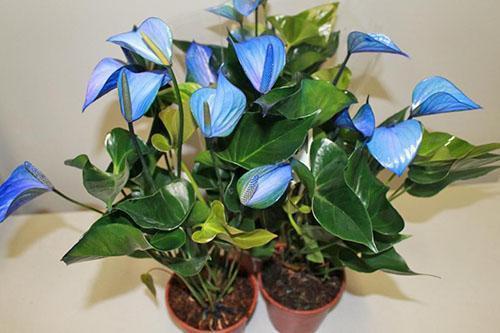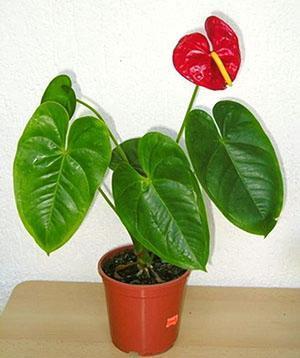Experienced florists tell you how to care for anthurium so that it pleases with its appearance
 The beautiful flower "Man's Happiness" is beautiful with its decorative, heart-shaped leaves. His flowers are beautiful - an ear in a fiery red, pink or speckled bedspread. If you comply with the conditions of detention, anthurium flower will always be smart. We will try to briefly outline the basic requirements of how to care for the atrium. With experience, their own developments will come, which can be shared with amateurs.
The beautiful flower "Man's Happiness" is beautiful with its decorative, heart-shaped leaves. His flowers are beautiful - an ear in a fiery red, pink or speckled bedspread. If you comply with the conditions of detention, anthurium flower will always be smart. We will try to briefly outline the basic requirements of how to care for the atrium. With experience, their own developments will come, which can be shared with amateurs.
Do I need to transplant the purchased anthurium

In addition, there are special requirements:
- complex composition of the earth;
- shape and size of the pot;
- quality of irrigation water and fertilizer;
- air humidity;
- lack of drafts.
The beauty of a flower depends on healthy leaves and abundant flowering. The slightest deviations in care will lead to a loss of decorativeness.
 So, a new pet appeared in the house. First of all, he must go through quarantine, that is, he must live separately from other flowers for two weeks. The best place for this period may be the bathroom. It's warm and humid there, and backlight it is not difficult to organize. During this time, diseases and pests will come to light, if any. Watering anthurium during this period should be scanty.
So, a new pet appeared in the house. First of all, he must go through quarantine, that is, he must live separately from other flowers for two weeks. The best place for this period may be the bathroom. It's warm and humid there, and backlight it is not difficult to organize. During this time, diseases and pests will come to light, if any. Watering anthurium during this period should be scanty.
Anthurium is a poisonous plant with a caustic sap. Therefore, it must be out of reach of children and animals. Leaving with pruning and replanting should only be carried out with protective glasses and gloves.
In the future, if everything is in order, you will need to transplant or transfer the plant. It should be borne in mind that the roots of anthurium are very fragile, and transplantation will invariably lead to injuries. Therefore, it is better to transfer the plant to a new pot and add earth around the edges without compaction. Choose a pot for anthurium with a smooth inner surface, slightly larger than the previous dishes. The roots should receive more nutrition, but a pot that is too spacious will prevent flowering. Until the container is filled with roots, the anthurium will not bloom. Therefore, you do not need to take a pot "for growth". Better to buy a plastic container, it is warmer.
 Recommendations to completely change the soil in the flower relate to cases when there is a suspicion of root disease or overflow is allowed. The plant gives a signal with spots on the leaves that there is a disorder with the roots. Then the plant is not only freed from the old earth, but the roots are carefully washed, dried and all questionable areas are cut out.
Recommendations to completely change the soil in the flower relate to cases when there is a suspicion of root disease or overflow is allowed. The plant gives a signal with spots on the leaves that there is a disorder with the roots. Then the plant is not only freed from the old earth, but the roots are carefully washed, dried and all questionable areas are cut out.
Planting land preparation and fertilization
 The main requirement for the substrate is that it should be light, breathable and with little acidity. Soil for anthurium should have the ability to absorb moisture, but not retain excess moisture. There are special formulations that you can buy. One of them is the Seramis clay granulate, which is a completely ready-made substrate. In others, even ready-made mixtures "Azalea" or "Saintpaulia", you need to add crushed bark, charcoal, coconut fiber or sphagnum moss, vermiculite and brick chips.
The main requirement for the substrate is that it should be light, breathable and with little acidity. Soil for anthurium should have the ability to absorb moisture, but not retain excess moisture. There are special formulations that you can buy. One of them is the Seramis clay granulate, which is a completely ready-made substrate. In others, even ready-made mixtures "Azalea" or "Saintpaulia", you need to add crushed bark, charcoal, coconut fiber or sphagnum moss, vermiculite and brick chips.
If the composition is prepared independently, then the mixture is taken as a basis in equal proportions:
- upper peat;
- leaf humus;
- sand;
- turf land with the addition of vermicompost.
 In this case, the soil for anthurium is completely steamed and processed with a strong solution of potassium permanganate. After that, it is dried to a free-flowing state, but with residual moisture. Expanded clay is used for the drainage layer, which is also subjected to disinfection. When planting a plant, the soil is not compacted or excessively moisturized. The roots must breathe. Deepen the plant to the neck. Over time, the roots show up on the surface. To prevent them from drying out, a fibrous material in the form of moss or coconut fiber should lie on top. Vermiculite is also suitable.
In this case, the soil for anthurium is completely steamed and processed with a strong solution of potassium permanganate. After that, it is dried to a free-flowing state, but with residual moisture. Expanded clay is used for the drainage layer, which is also subjected to disinfection. When planting a plant, the soil is not compacted or excessively moisturized. The roots must breathe. Deepen the plant to the neck. Over time, the roots show up on the surface. To prevent them from drying out, a fibrous material in the form of moss or coconut fiber should lie on top. Vermiculite is also suitable.
 Since the soil is not very nutritious, then a month after transplanting the plant must be fed. During the growth period, extracts from organic or special fertilizers for anthurium, ornamental flowering plants, and aroid are added to the irrigation water.
Since the soil is not very nutritious, then a month after transplanting the plant must be fed. During the growth period, extracts from organic or special fertilizers for anthurium, ornamental flowering plants, and aroid are added to the irrigation water.
Anthuriums often suffer from excessive care. Everything in moderation. Fertilizers in a half dose of that indicated on the package. Watering when the top layer dries and in small portions. The drip tray must not stand directly under the drain hole without a gap.
Agricultural technology in winter
 All aroids, including anthurium, have a dormant period in winter. All life processes slow down at this time. Therefore, the air temperature should be lowered to 18 degrees, but at 15 the plant will freeze. A signal that the roots are cold is the appearance of brown spots or a completely brown leaf. Then you need to slightly warm up the legs of the plant.
All aroids, including anthurium, have a dormant period in winter. All life processes slow down at this time. Therefore, the air temperature should be lowered to 18 degrees, but at 15 the plant will freeze. A signal that the roots are cold is the appearance of brown spots or a completely brown leaf. Then you need to slightly warm up the legs of the plant.
Daylight hours should be about 10 hours. Therefore, in winter, supplementary lighting in regions close to the Arctic will be useful. There is only 6 hours of daylight in December. Watering in winter is reduced the more, the lower the temperature, but the clod of earth should not be allowed to completely dry out. With excessive moisture, root rot is inevitable.
 Spraying anthurium in winter is rarely done, once a week. In this case, you should constantly remove dust from the leaves with a wet cloth. Appearing yellow spots are a signal of insufficient lighting. Brown spots in the middle of the leaf indicate cold content. Drying leaf edges signal dry air. In addition, you need to examine the plant for colonization with scale insects, aphids, thrips.
Spraying anthurium in winter is rarely done, once a week. In this case, you should constantly remove dust from the leaves with a wet cloth. Appearing yellow spots are a signal of insufficient lighting. Brown spots in the middle of the leaf indicate cold content. Drying leaf edges signal dry air. In addition, you need to examine the plant for colonization with scale insects, aphids, thrips.
Anthurium should not be transplanted in winter, you need to wait for its awakening. But if it has been poured, and the situation is emergency, then you can try when it’s not enough to reach the spring. In winter, the survival rate of the atrium is low.
Watering requirements
 Water the anthurium only with soft, settled water. If scale remains on the dishes, such water is destructive for anthurium. Bright brown spots on the leaves will indicate this. Hard water on the pot leaves white stains on the ground and a light strip along the line of the soil boundary. Soft water can be obtained by boiling, or by passing it through a softener filter. You can use ice or snow. But always the irrigation water should be about 30 0 and does not contain chlorine. Moistening the earth is done in small portions. If watering is bottom, then after 30 minutes the water is drained. An hour later, after the excess leaves through the drainage hole, the pan is again drained.
Water the anthurium only with soft, settled water. If scale remains on the dishes, such water is destructive for anthurium. Bright brown spots on the leaves will indicate this. Hard water on the pot leaves white stains on the ground and a light strip along the line of the soil boundary. Soft water can be obtained by boiling, or by passing it through a softener filter. You can use ice or snow. But always the irrigation water should be about 30 0 and does not contain chlorine. Moistening the earth is done in small portions. If watering is bottom, then after 30 minutes the water is drained. An hour later, after the excess leaves through the drainage hole, the pan is again drained.
The most important condition for anthurium is the creation of a moisture zone. For this, a fine spray is applied over the plant in summer several times a day, in winter once a week. Rubbing the leaves with a damp cloth several times a day in summer serves the same purpose. At humidity below 65%, the leaves of anthurium will dry out from the edges.
 If the leaf blades are dry and look poor, they can be trimmed with disinfected scissors. It is recommended to cut the leaves of the anthurium when there are a lot of them, so as not to overload the root system. In this case, the cut points must be sprinkled with crushed charcoal or cinnamon powder.
If the leaf blades are dry and look poor, they can be trimmed with disinfected scissors. It is recommended to cut the leaves of the anthurium when there are a lot of them, so as not to overload the root system. In this case, the cut points must be sprinkled with crushed charcoal or cinnamon powder.